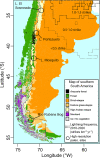Disentangling the last 1,000 years of human-environment interactions along the eastern side of the southern Andes (34-52°S lat.)
- PMID: 35193983
- PMCID: PMC8892505
- DOI: 10.1073/pnas.2119813119
Disentangling the last 1,000 years of human-environment interactions along the eastern side of the southern Andes (34-52°S lat.)
Abstract
Researchers have long debated the degree to which Native American land use altered landscapes in the Americas prior to European colonization. Human-environment interactions in southern South America are inferred from new pollen and charcoal data from Laguna El Sosneado and their comparison with high-resolution paleoenvironmental records and archaeological/ethnohistorical information at other sites along the eastern Andes of southern Argentina and Chile (34-52°S). The records indicate that humans, by altering ignition frequency and the availability of fuels, variously muted or amplified the effects of climate on fire regimes. For example, fire activity at the northern and southern sites was low at times when the climate and vegetation were suitable for burning but lacked an ignition source. Conversely, abundant fires set by humans and infrequent lightning ignitions occurred during periods when warm, dry climate conditions coincided with ample vegetation (i.e., fuel) at midlatitude sites. Prior to European arrival, changes in Native American demography and land use influenced vegetation and fire regimes locally, but human influences were not widely evident until the 16th century, with the introduction of nonnative species (e.g., horses), and then in the late 19th century, as Euro-Americans targeted specific resources to support local and national economies. The complex interactions between past climate variability, human activities, and ecosystem dynamics at the local scale are overlooked by approaches that infer levels of land use simply from population size or that rely on regionally composited data to detect drivers of past environmental change.
Keywords: fire history; human–environment; paleoecology; southern South America; vegetation history.
Conflict of interest statement
The authors declare no competing interest.
Figures



Comment in
-
The historical and archaeological evidence for Southern Cone human-environment interaction.Proc Natl Acad Sci U S A. 2022 Mar 22;119(12):e2201496119. doi: 10.1073/pnas.2201496119. Epub 2022 Mar 15. Proc Natl Acad Sci U S A. 2022. PMID: 35290125 Free PMC article. No abstract available.
References
-
- Whitlock C., Colombaroli D., Conedera M., Tinner W., Land-use history as a guide for forest conservation and management. Conserv. Biol. 32, 84–97 (2018). - PubMed
-
- Delaunay A. N., Belardi J. B., Marina F. C., Saletta M. J., De Angelis H., Glass and stoneware knapped tools among hunter-gatherers in southern Patagonia and Tierra del Fuego. Antiquity 91, 1330–1343 (2017).
MeSH terms
LinkOut - more resources
Full Text Sources
Research Materials
Miscellaneous

